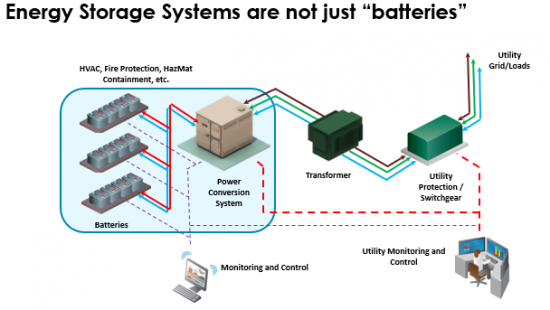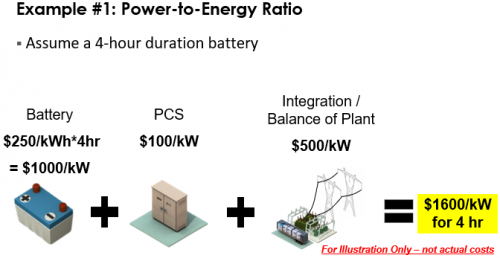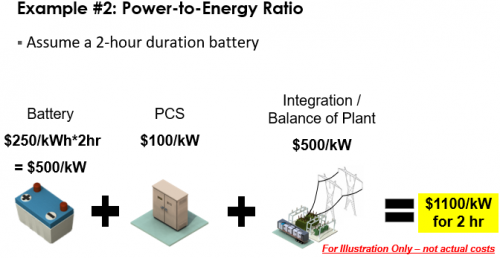Difference between revisions of "Energy Storage 101/Economics"
MichaelRosen (talk | contribs) |
MichaelRosen (talk | contribs) |
||
| Line 10: | Line 10: | ||
Other generation resource costs are often communicated on a $/kW basis, but energy storage has both power and energy components and the normalized cost will vary with duration. This is highlighted in two examples below where it's clear that the longer duration system has a higher cost per kW of power. | Other generation resource costs are often communicated on a $/kW basis, but energy storage has both power and energy components and the normalized cost will vary with duration. This is highlighted in two examples below where it's clear that the longer duration system has a higher cost per kW of power. | ||
<div><ul> | <div><ul> | ||
<li style="display: inline-block;"> [[File:Es101cost20.png|thumb|none|500px|Source: EPRI. 4 Hour Duration System.]] </li> | <li style="display: inline-block;"> [[File:Es101cost20.png|thumb|none|500px|Source: EPRI. 4 Hour Duration System.]] </li> | ||
<li style="display: inline-block;"> [[File:Es101cost30.png|thumb|none|500px|Source: EPRI. 2 Hour Duration System.]] </li> | <li style="display: inline-block;"> [[File:Es101cost30.png|thumb|none|500px|Source: EPRI. 2 Hour Duration System.]] </li> | ||
</ul></div> | </ul></div> | ||
The image below shows lithium ion cost projections from a [https://www.epri.com/research/products/000000003002020048 2020 EPRI cost study]. As demonstrated in the two examples above, the longer duration systems, as of 2020, are more expensive per kW than the shorter duration systems. However, EPRI's cost study projects that the cost per kW of 8 hour duration lithium ion systems is decreasing at a faster rate than 2 hour lithium ion systems. | |||
[[File:Li_Ion_Cost_Projection_2020.png|none|thumb|550px|Source: EPRI. "Lithium Ion Installed Cost Projections": [https://www.epri.com/research/products/000000003002020048 Battery Energy Storage Lifecycle Cost Assessment Summary 2020]]] | [[File:Li_Ion_Cost_Projection_2020.png|none|thumb|550px|Source: EPRI. "Lithium Ion Installed Cost Projections": [https://www.epri.com/research/products/000000003002020048 Battery Energy Storage Lifecycle Cost Assessment Summary 2020]]] | ||
Revision as of 17:26, 3 May 2021
Cost Components and Trends
Clarity on costs is a critical step in energy storage economics. Economic analysis of energy storage systems need to clearly articulate what major components are included in the scope of cost. The schematic below shows the major components of an energy storage system. System components consist of batteries, power conversion system, transformer, switchgear, and monitoring and control. A proper economic analysis identifies the cost associated with each of these components or provides reasoning for exclusion.
In addition to identification of major components, there are key BESS services that occur throughout the system's lifetime that need to be accounted for in an economic analysis. The left side of the graphic below shows the beginning of life stacked costs for battery energy storage systems. As shown in the upfront owners' costs, the largest upfront cost is the battery itself. One important consideration given the significant battery cost are the sizing assumptions that are used for cost estimates. Of the procured energy, a fraction of that energy is delivered to the customer and some fraction is reserved for safety and performance margins, degradation overbuild, AC/DC losses, or is electrochemically inaccessible. Additionally, the graphic shows costs of services throughout BESS operation. These services include operating expenses, fixed system maintenance, and decommissioning and end of life services.
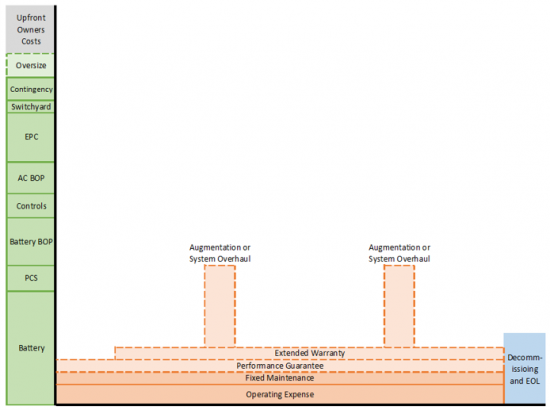
Other generation resource costs are often communicated on a $/kW basis, but energy storage has both power and energy components and the normalized cost will vary with duration. This is highlighted in two examples below where it's clear that the longer duration system has a higher cost per kW of power.
The image below shows lithium ion cost projections from a 2020 EPRI cost study. As demonstrated in the two examples above, the longer duration systems, as of 2020, are more expensive per kW than the shorter duration systems. However, EPRI's cost study projects that the cost per kW of 8 hour duration lithium ion systems is decreasing at a faster rate than 2 hour lithium ion systems.
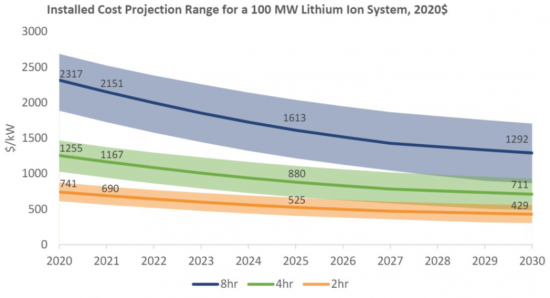
Grid Services and Uses
Energy storage has many capabilities:
- Capacity Resource: Firm power
- Flexibility Resource: Fast response and ramping
- Backup Resource: Energy reserve
- Power Quality Resource: 4-quadrant watts and VARs
The table below list the grid services energy storage can support.
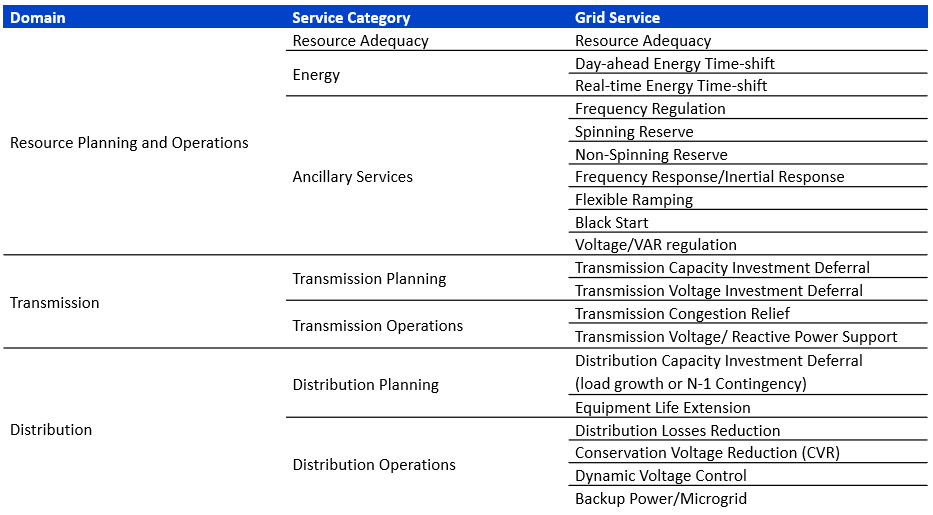
Transmission-connected storage may provide:
- Generation capacity (resource adequacy)
- Black start
- Virtual transmission capacity
- Energy time-shifting
- Ancillary services
Distribution-connected storage may provide:
- Virtual distribution capacity
- Enhance power quality
- Resiliency / backup power / microgrid
- Upstream transmission impacts – either costs or benefits
Customer-connected storage may provide:
- Customer bill savings: Retail time-of-use tariff energy shifting, Demand charge management
- Backup power
- Upstream T&D impacts – either costs or benefits
Modeling Energy Storage
Challenges to modeling energy storage include:
- Storage is not yet a common grid asset
- Rules and regulations are still evolving
- Benefit stacking is appealing, but is it possible?
- More services = more value
- More services = more requirements
- Can these requirements be satisfied?
- Storage value analyses are site-specific
- Complex co-optimization between storage technologies, objectives, and constraints
Understanding Service Compatibility
- Energy Storage Services Hierarchy
- Energy storage services only flow from bottom up, customer storage may provide distribution and transmission-level services, but transmission storage can NOT provide distribution or customer services
- Reliability vs. Economic
- Reliability takes priority (e.g. T&D deferral higher priority than market services)
- Long-term planning constraints take priority to economic optimization and constraints roll-up; Multi-year >> Annual >> Monthly >> Day-ahead >> Real-time
- Local vs. System Level
- Local objectives generally supersede system objectives when there is a conflict (e.g. T&D deferral higher priority than resource adequacy) although should be designed so that reliability services never conflict
Resources
EPRI Tools to Support Valuation Modeling
StorageVET
DER-VET
Reports
| Resource | Access Level |
|---|---|
| EPRI Solar Plus Storage Cost Assessment and Design Considerations: Executive Summary (2019) | Publicly Available |
| EPRI Energy Storage Technology and Cost Assessment: Executive Summary (2018) | Publicly Available |
| ESIC Energy Storage Cost Tool and Template | Publicly Available |
| Energy Storage Valuation in California: Policy Planning and Market Information Relevant to the StorageVET Model | Publicly Available |
